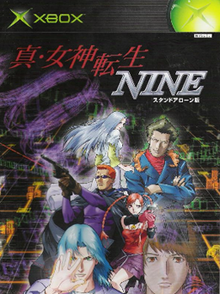| Shin Megami Tensei: Nine | |
|---|---|
 Cover art | |
| Developer(s) | Atlus NexTech |
| Publisher(s) | Atlus |
| Director(s) | Kazunori Sakai |
| Producer(s) | Kouji Okada |
| Programmer(s) | Akihiro Yoshida |
| Artist(s) | Yasuomi Umetsu Kazuma Kaneko |
| Writer(s) | Nobutaka Shimizu Yumiko Kurihara Yutaka Toyama |
| Composer(s) | Takahiro Ogata Masaki Kurokawa |
| Series | Megami Tensei |
| Platform(s) | Xbox |
| Release |
|
| Genre(s) | Role-playing |
| Mode(s) | Single-player |
Shin Megami Tensei: Nine[a] is a 2002 role-playing video game developed by Atlus and NexTech, and published by Atlus for the Xbox. Forming part of the Megami Tensei series, Nine takes place in the period of time between Shin Megami Tensei and its sequel, with the survivors of Tokyo's destruction sheltering in underground bunkers. Taking on the role of a debugger, the player navigates the Idea Space virtual world set up by the survivors of Tokyo's destruction, which has come under attack by demonic beings called "noise". The gameplay has the player navigating a customized avatar in third-person through the virtual world of Tokyo, battling enemies using a real-time command-based battle system. Despite its title, it is the eighth game in the Megami Tensei series. The game's title instead refers to the number of possible moral alignments available to players.
Shin Megami Tensei: Nine began development in 2001, following staff discussions about how to make an online Shin Megami Tensei game. It was the first Megami Tensei title for Xbox, and the first to fully utilize 3D graphics. Established Megami Tensei staff worked on the project, such as producer Kouji Okada and demon designer Kazuma Kaneko. Newcomers to the project included character designer Yasuomi Umetsu, and composers Masaki Kurokawa and Takahiro Ogata. While Nine was originally planned as an online game, it was split into single-player and online versions; the latter was cancelled following development difficulties. The single-player release met with mixed reception from critics, and sold below Atlus' estimates; its commercial failure coupled with development costs contributed to a financial loss. Development of the online version continued as a port for Microsoft Windows, which would eventually become Shin Megami Tensei: Imagine.
Cite error: There are <ref group=lower-alpha> tags or {{efn}} templates on this page, but the references will not show without a {{reflist|group=lower-alpha}} template or {{notelist}} template (see the help page).